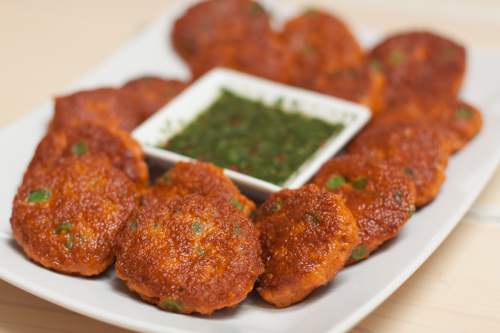Recipes for lockdown: Thai fish cakes
 Friday, April 24, 2020 at 9:03PM
Friday, April 24, 2020 at 9:03PM 
If you have some leftover red curry paste from my last lockdown recipe, then this is a great way to use it up.
Thai fishcakes are one of my favourite Thai snacks. I often make them as a canapé or starter for an Asian themed meal, because they are incredibly easy, but deceptively so – people are always very impressed that I have made them from scratch. I prepare the mix ahead of time and shallow fry them till golden on the outside, but not cooked through, then finish them in the oven when I am ready to serve. Less faff and means I can actually talk to my guests.
The fish cake recipe is based on David Thompson’s, but with a few of the more exotic, hard to find ingredients replaced with things you can easily get in your local supermarket. If you can’t get fresh kaffir lime leaves, don’t substitute for dried, just skip them or use zest of lime instead. Likewise, the original recipe calls for snake beans, but I have never seen them in a shop in London, Asian or otherwise, so I just use fine green beans.
Most Thai restaurants serve these with a light, sweet and sour dipping sauce, which is probably the ideal dressing because you can really taste the fish cakes. However, I like things bold and brash when it comes to Thai food, so I make my own bastardisation of a Thai dressing packed full of herbs and spice and doused in lashings of fish sauce. I’ve provided both options below, so take your pick. They’re also good with shop bought Thai sweet chilli sauce if you feel you’ve done enough cooking for one day.
This recipe can easily be doubled or tripled for a big group. The mix also freezes well if you have leftovers, though fresh fish is obviously preferable.
Makes 15 fish cakes, approx.

Ingredients
300g white fish fillets, e.g. haddock
4 tbsp red curry paste
1 egg, lightly beaten
3 tbsp fish sauce
1 tsp caster sugar
5 kaffir lime leaves (or substitute for zest of 1 lime)
2 tbsp fine green beans, finely sliced
Vegetable oil, for frying
Method
Preheat the oven to 180C; this recipe assumes you will be cooking these at home and frying in small batches, so this is to keep the fish cakes warm and finish cooking them through.
To make the fish cakes, remove the skin from the fillets if it hasn’t already been removed and check that all bones have been removed.
Roughly chop the fish and put in a blender along with the red curry paste, egg, fish sauce and sugar and blend to a thick paste.
Put the mixture into a large, wide bowl and use your hands to gather it into a ball and throw it down hard into the bowl, making a slapping sound. This is to aerate the mixture so that it puffs up when it is fried. Continue doing this until the mixture becomes firmer and sticker.
Mix in the lime leaves and green beans*.
Shape the mixture into disks, approx. 15mm thick and place on a plate or tray lined with baking paper.
To shallow fry: fill a frying pan with 2cm vegetable oil and place over a medium-high heat. Fry the fishcakes for 1 to 2 minutes on each side or until golden. Transfer to a plate lined with kitchen roll to remove any excess oil and then put on a tray in the oven while you fry the rest.
To deep fry: fill a deep saucepan with at least 10cm vegetable oil and place over a high heat. To test the temperature, put a tsp of the mixture in the oil – it should start sizzling and turn golden straight away. When you have the right temperature turn the heat down to medium. Deep fry for 1 to 2 mins. As above, transfer to a plate lined with kitchen roll to remove any excess oil and then put on a tray in the oven while you fry the rest.
If you are not putting in the oven, then you will need to fry the fish cakes for a minute or two more. You can check if the fish cakes are done by cutting one in half. It should be a consistent colour all the way through; if it's not cooked, there will be a raw patch in the centre.
* If you are making the mixture ahead of time, mix the lime leaves and green beans in after blending the mixture, but leave the ‘slapping’ process till just before cooking.

Dipping sauce option 1: Sweet and Sour
Ingredients
3 tbsp rice or white wine vinegar
4 tbsp water
3 tbsp white sugar, or to taste
1 red chilli, cut into thin rounds
Salt, to taste
Method
Put the vinegar, sugar and water in a small saucepan and bring to the boil. Remove from the heat and leave to cool. Stir in the chilli and season with salt, to taste.
Dipping sauce option 2: Herbs and Heat
Ingredients
60ml lime juice
20ml fish sauce, or to taste
1 tsp sugar, or to taste
1 red birds eye chilli, finely chopped
1 tsp sesame oil, or to taste
Handful coriander leaves, finely chopped
Handful mint leaves, finely chopped
Method
Mix the lime juice, fish sauce and sugar together in a small bowl or shake in a jar, until the sugar has dissolved. Add the chilli and sesame oil, to taste. Just before serving, add the fresh herbs.

Reader Comments (1)
The best recipe for the lockdown leftover red curry paste and used it in very tasty Thai snacks Best Seafood in Karachi